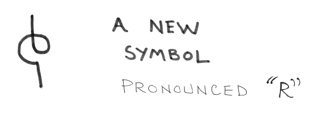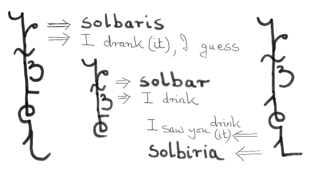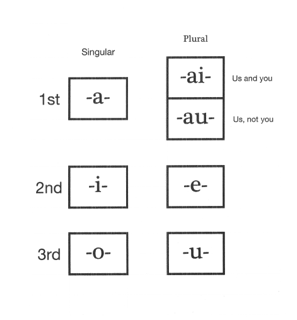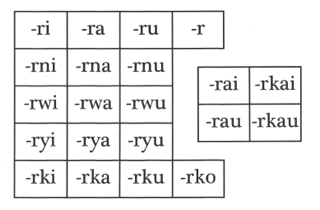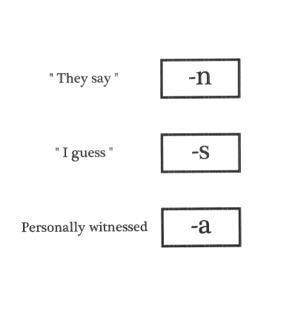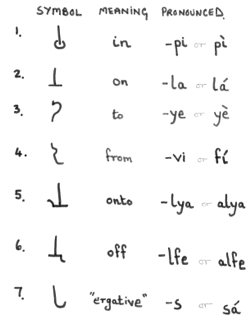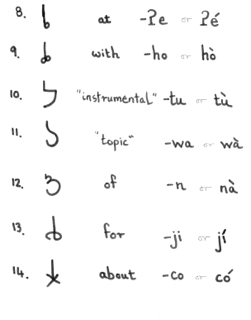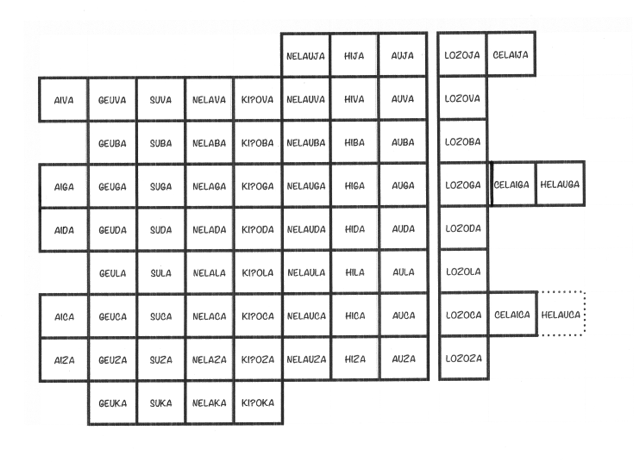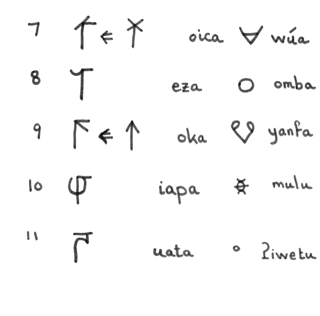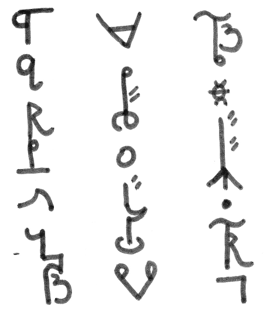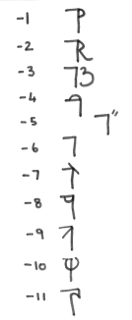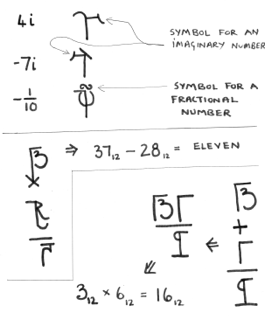Béu : Chapter 3: Difference between revisions
| Line 85: | Line 85: | ||
The '''kolape''' above, if expressed as a main clause would be. | The '''kolape''' above, if expressed as a main clause would be. | ||
'''(pás) solbari | '''(pás) solbari moze pona sacowe''' = I drank the cold water quickly | ||
There are 4 types of '''kolape cwidau''' or complement clause. | There are 4 types of '''kolape cwidau''' or complement clause. | ||
Revision as of 19:13, 14 January 2013
..... Building up a noun phrase ... "cwidauza"
Now we talk about the béu noun phrase (cwidauza). This can be described as ;-
Quantifier1 Head2 (Adjective3 x n) Genitive4 Determiner5 Relative-clause6
1) The Quantifier is either a number or a word such as "all", "many", "a few" etc.
2) The head is usually a noun but can also be an adjective. When you come across an adjective as head of a noun phrase, its meaning is "the person/thing that is "adjective" ".
3) An adjective ... not much to say about this one, you can have as many as you like, the same as English.
4) A Genitive is made from a noun (and I guess an adjective as defined in 2) ) with an n suffix. It says that the head has some quality or relationship to the genitive.
5) Either dí "this", or dè "that".
6) This is a clause, beginning with tà that qualifies the head of the noun phrase.
An interesting point is that in the absence of a "head" any of the other 5 elements can constitute a NP by itself.
..... Another type of noun phrase ... kolape
kolape is a complement clause or a relative clause in the béu linguistic tradition
kolape is when a clause is modified slightly and functions either as an adjective modifying a noun (a relative clause) or as a noun being one of the core arguments in another clause.
kolape saidau
kolape saidau is a relative clause construction which works in pretty much the same way as the English relative clause construction. A relative clause is a clause that qualifies a noun. It is introduced by a special particle, tà in béu. In English it is usually "that" but a number of other words can also be used. The noun that is being qualified is dropped from the relative clause, but the roll which it would play is shown by its pilana on the relativizer tà. For example ;-
glá tà bwàs timpori rà hauʔe = The woman that the man hit, is beautiful. ... If the clause that is qualifying the noun appeared in isolation, it would be - bwàs timpori glá ... glá is the O argument and hence is unmarked.
glá tà flompori rà hauʔe = The woman that tripped is beautiful. ... If the clause that is qualifying the noun appeared in isolation, it would be - glá flompori ... glá is the S argument and hence is unmarked.
bwà tàs timpori glá rà ʔaiho = The man that hit the woman is ugly. ... If the clause that is qualifying the noun appeared in isolation, it would be - bwàs timpori glá ... bwà is the A argument and hence has pilana number 7 "-s", which is transferred to the relativized tà when bwà disappears.
The same thing happens with all the pilana*. For example ;-
the basket tapi the cat shat was cleaned by John.
the wall tala you are sitting was built by my grandfather.
the woman taye I told the secret, took it to her grave.
the town tavi she has come is the biggest south of the mountain.
the lilly pad talya the frog jumped was the biggest in the pond.
the boat talfe you have just jumped is unsound
bwà tàs timpori glá rà ʔaiho = The man that hit the woman is ugly.
nambo taʔe she lives is the biggest in town.
bwà taho ò is going to market is her husband.
the knife tatu he severed the branch is a 100 years old
the man tan dog I shot, reported me to the police = the man whose dog I shot, reported me to the police**
The old woman taji I deliver the newspaper, has died.
The boy taco they are all talking, has gone to New Zealand.
* Well all the pilana except -wa. This pilana sets the noun it qualifies to the status of "topic". The time for which a noun will retain its "topicality" is usually much longer than a clause.
**Altho' this has the same form as all the rest, underneath there is a difference. n marks a noun as part of a noun phrase, not as to its roll in a clause.
kolape cwidau
kolape cwidau is a complement clause construction.
In kolape saidau the word order is free. This is not so in kolape cwidau
jono rì kéu = John was bad
(pà solbe moze pona sacowe)S rì kéu = my drinking the cold water quickly was bad
Notice that pà solbe moze pona sacowe behaves as one element. It has the same function as "John" in the previous example.
A main clause has free word order with regards to the verbs and main arguments. However the word order inside kolape is fixed. It must be S V or A V O for a transitive clause (any other peripheral arguments are stuck on at the end).
Also notice that the ergative marker -s which is usually attached to the A argument is dropped. Actually for pronouns it is not just the dropping of the -s, but a change of tone also, so this form is identical to the O form of the pronoun.
The kolape above, if expressed as a main clause would be.
(pás) solbari moze pona sacowe = I drank the cold water quickly
There are 4 types of kolape cwidau or complement clause.
kolape ju??
The example in last section was kolape ju. In form it is just the base form of the verb gomia.
wàr solbe (I want to drink) is another example. (wò = to want)
kolape lá
This form is based on the base verb form with -la suffixed. For example ...
klori jono timpala jene (he saw John hitting Jane) ... (klói = to see)
kolape tà
In this form the full verb* is used, not the gomia. Also we have a special complementiser particle tà which comes at the head of the complement clause (the same particle that heads the relative clauses).
wàr tà jono timporu jene = I want John to hit Jane
*Well not quite the full vern. Evidentials are never expressed in complement clauses.
kolape tavoi
This is equivalent to English word "whether".
sa RAF kalme Luftwaffe kyori Hitler olga tena => The RAF's destruction of the Luftwaffe, made Hitler think again. ... here a gomiaza acts as the A-argument.
*in the combinations where sacowe immediately followed solbe it is merely saco
Things to think about
what about "who" or "what" introducing a relative clause ?
what is a gomiaza
Can this be used for a causative construction ??
..... The main verb form
This is also called the R-form
So far we haven't said much about the verb as such, although we have come across the infinitive (gomia).
We will discuss the most-used form of the verb in this section, the R-form. But first we should introduce a new letter.
Above it is shown appearing in some active verbs. Just remember to put an extra little florish on the "r" when it occurs word finally, just to distinguish it from word final "j".
This letter has not been mentioned so far because it doesn't occur in any words as such. It only occurs in the R-form of the verb.
So if you hear "r" or see the above symbol, you know you are hearing the main verb of a clause. (definition of a clause (semo) = that which has one "r" ... ??? )
O.K. ... the R-form is built up from the gomia*.
1) the final vowel is deleted from the gomia.
2) one of the 7 vowels below is added.
LINGUISTIC JARGON ... In the Western linguistic tradition, these markers are said to represent "person" and "number". Person is either first, second or third person (i.e. I, you, he or she). In the béu linguistic tradition they are called cen@o-markers.
3) now one of the 21 markers shown below is added.
Now these markers represent what are called tense/aspect markers in the Western linguistic tradition. In the béu linguistic tradition, they are called gwomai or "modifications". (gwoma = to alter, to modify, to adjust, to change one altribute of something).
Add finally we can OPTIONALLY add one of three evidentially markers. So ;-
4) now one of the 3 markers shown below is can be added.
O.K. and now to explain the system.
First the 7 the cenʔo-markers. (cen@o = musterlist, people that you know, acquaintances, protagonist, list of characters in a play)
These markers represent the subject (the person that is performing the action). Whenever possible the pronoun that represents the subject is dropped, it is not needed because we have that information inside the verb with the cenʔo-markers.
Notice that there are 2 entries that represent the 1st person plural subject (i.e. we). The top one must be used when the people performing the action included the speaker, the spoken to and possibly others. The lower one must be used when the people performing the action include the speaker, NOT the person spoken to and one or more 3rd persons.
Note that the ai form is used where in English you would use "you" or "one" (if you were a bit posh) ... as in "YOU do it like this", "ONE must do ONE'S best, mustn't ONE".
LINGUISTIC JARGON ... This pronoun is often called the "impersonal pronoun" or the "indefinite pronoun".
So we have 7 different forms for person and number.
Now we can see we have a comprehensive array of tense/aspect markers here. You could say I have thrown everything but the kitchen-sink in :-) ... however better to have a neat system like this than adding spurious "helper" verbs all over the place.
Looking at the bigger block, you can see the first 3 columns differ by their vowel. These are the tenses ... i for the past, a for the present and u for the future.
-ri ... This is the plain past tense. This is most often used when somebody is telling a story (a narrative). For example "Yesterday I got up, ate my breakfast and went to school". All three verbs in this narrative use the plain past tense.
-ra ... Should only be used if the action is happening NOW. English uses "to be xxxing". For example doikara = I am walking ... (doika = to walk)
-ru ... This is the future tense and of course as such, in many situations is a bit uncertain.
-r ... This has no time reference. It might be used for timeless "truths" such as "the sun rises in the West" or "birds fly".
The next row has what is called the habitual aspect. English has a past habitual (i.e. I used to go to school), and often in English the plain form of the verb is used as a habitual with no time reference (i.e. I drink beer). Actually in béu the pattern is broken a bit, in that -rna has NOTHING to do with the activity going on at the time of speech, it is actually a tenseless habitual. Also béu and English behave in the same in the following way ... whereas by logic we should use doikarna in "I walk (to school everyday)", in fact doikar is used. doikarna would be used only if we were going on to MENTION some exception (i.e. but last tuesday Allen gave me a lift)
doikarna = "sometimes I walk, and sometimes I choose not to walk" or even "I usually walk". If you walked on every occasion that was possible, then you would use doikar
-rnu ... Now English doesn't have a future habitual. But if it did it would have a roll. For instance, suppose you have just moved to a new house and are asked "how will you get to the supermarket". In béu you would answer doikarnu.
The next row expresses the perfect tense.
While the perfect tense, logically this doesn't have that much difference from the past tense it is emphasising a state rather than an action. It represents the state at the time of speaking as the outcome of past events. We have this tense/aspect in English and it is realized as "have xxxxen". For example if you wanted to talk to John and you went to his office, his secretary might say "he has gone to lunch" (as opposed to "he went for lunch"), which emphasises the absence of John. And think about the difference in meaning between "she has fallen in love" and "she fell in love" ... the first one means "she is in love" while the second one just talks about some of her history.
Another use for this tense is to show that something has happened at least once in the past. For example "I have been to London".
Easy to translate into English ... doikorwi = He/she had walked ... doikorwa = He/she has walked ... doikorwu = He/she will have walked
The next row expresses the "not yet" tense.
Easy to translate into English ... doikoryi = He/she had not yet walked ... doikorya = He/she hasn't walked yet ... doikoryu = He/she will not have walked
Notice that the English translation, doikoryu is just the negative of doikorwu. Interesting eh ? In fact these two aspects can be in many ways regarded as the negatives of each other, although in English only the future tense gives the surface forms this way.
Which leads us on to the next row. This row gives the negatives of row 1 and row 2 (that is right, row 2 does not have its own negative). And notice the tenseless negative has the vowel o added. This is just to make it pronounceable (for the native béu speaker of course, I know YOU could pronounce *doirork). An o is also used to connect word final '"r" to the evidential markers "n" and "s".
Easy to translate into English ... doikorki = He/she didn't walk ... doikorka = He/she doesn't walk ... doikorku = He/she will not walk
The smaller block with the 4 markers will be explained later.
Even with these 21 markers, you will come across some natural language that will make a distinction that béu can not make.
For example suppose two old friends from secondary school meet up again. One is a lot more muscular than before. He could explain his new muscles by saying "I have been working out" (using the progressive plus the perfect aspects). The "have" is appropriate because we are focusing on "state" rather than "action". The "am working out" is appropriate because it takes many instances of "working out" to build up muscles.
Every language has a limited range of ways to give nuances to an action, and language "A" might have to resort to a phrase to get a subtle idea across while language "B" has an obligatory little affix on the verb to economically express the exact same idea. You could swamp a language with affixes to exactly meet every little nuance you can think of (you would have an "everything but the kitchen sink" language). However in 99% of situations the nuances would not be needed and they would just be a nuisance.
By the way, in the above example, the muscular schoolmate would use the r form of the verb, to explain his present condition.
Next the 3 teŋko-markers ... teŋkai is a verb, meaning "to prove" or "to testify" or "to give evidence" or "to demonstrate" ... teŋko is a noun derived from the above, and means "proof" or "evidence".
About a quarter of the worlds languages have, what is called "evidentiality", expressed in the verb. (It is unknown in Europe so most people have never heard of it) In a language that has "evidentials" you can say (or you must say) on what evidence you are saying what you are saying. In béu there are 3 evidential affixes which can OPTIONALLY be added to the verb.
doikori = He/she walked ... this is neutral. The speaker has decided not to tell on what evidence he is saying what he is saying.
a) doikorin = They say he/she walked ... It this case the speaker is asserting "he walked" because somebody (or some people) have told him so.
b) doikoris = I guess he walked ... It this case the speaker is asserting "he walked" because he worked it out somehow.
The above 2 tenko are introducing some doubt, compared to the plain unadorned form (doikori). The third tenko on the contrary, introduced more certainty.
c) doikoria = I saw him walk ... In this case the speaked saw the action with his own eyes. This form can also be used if the speaker witnessed the action thru' another of his senses (maybe thru' hearing for example), but in the overwhelming majority of cases where this form is used, it means "I saw it myself".
This teŋko can only be used with one of the gwomai . It can ONLY be used with the plain passed tense form i.
By the way, the béu terms for the five aspects represented by these 5 rows are ... baga, dewe, pomo, fene, and liʒi.
It is worth mentioning that the béu letter that negates verbs is very similar to the Chinese character that negates verbs (bù) ... just a co-incidence.
*Excepts in rare cases (see "Adjectives and how they pervade other parts of speech")
..... Linking words
Also called copula's
The 2 verbs sàu and gaza are special verbs. (LINGUISTIC JARGON ... They are called copulas... in Latin "copulare" meant "to tie", so a copula is a verb that ties. In béu they differ from normal verbs, in that they require a specific word order. Also s (the ergative case) is never suffixed to a noun, as normally happens when a verb is associated with two nouns.
..... gaza ... the copula of existence
The copula complement of gaza ia always a noun or a noun phrase. It is how you say "there is ... "
gaza is similar to sàu in that it takes the 9 verb modifiers but 3 of them are wildly irregular. It is the same 3 tense/aspect forms that are irregularin the sàu copula. Namely ;-
*gazora => ʔá meaning "there is"
*gazori => ʔái meaning "there was"
*gazoru => ʔáu meaning "there will be"
Actually while theoretically gaza can have the full range of modifiers enjoyed by a normal verb, in reality all forms other than ʔá, ʔái, ʔáu are extremely rare. Occasionally you come across the "infinitive" gaza.
There is no word that corresponds to "have". The usual way to say "I have a coat" is "there exists a coat mine" = ʔá kaunu nà pà
Internal possessives are not allowed in the nouns introduced with gaza. That is, you can not say *ʔá kaunapu, but must say ʔá kaunu nà pà (I have a coat)
As I said above, gaza always comes with one noun. If it comes with an adjective, then that adjective can be considered a noun (well this is one way to look at it)
Also note that when the noun is a noun as opposed to an adjective, ??? , it is always indefinite.
pona = cold (an adjective), ponan = coldness (a noun)
ʔá ponan = "it is cold"
ʔá pona paye meaning "I feel cold" (word for word ... "there is coldness to me")
There is fixed word order : it is always gaza followed by the noun or NP.
The three irregular forms have their own negative marker. ya is stuck on to the end of the copula.
ʔaya ponan = "it is not cold"
Note that the word ʔaya (there is not) and ʔaiya (there was not) are very close to each other phonetically. However the middle part of the second word takes twice as long as the middle part in the first word : they are phonetically quite distinct.
The particles lói (probably) and màs (maybe) normally, come before the verb that they qualify. However the 3 irregular forms of gaza really like to come clause initially. Hence lói and màs immediately follow the verb.
ʔáu lói ponan = It will probably be cold
Also the evidentials are affixed to the wild forms, just as normal.
ʔaunya lói pona = They say it will probably not be cold
ʔaunya.foi lói pona = Do they say it will probably not be cold ?
..... sàu ... the main copula
sàu is the béu copula. That is it is the equivalent of "to be" in English, whish has such forms as "be", "is", "was", "were" and "are".
This verb is slightly irregular in béu as well. The three forms *sari, *saru and *sara which you would expect to see, are replaced with rì, rù and rà
Notice that person and number is not included in these three irregular forms, so it is sometimes necessary to have a pronoun in situations where it would normally be dropped.
Actually rà is usually missed out completely.
It is mostly used for emphasis; like when you are refuting a claim
Person A) ... gì mò rà moltai = You aren't a doctor
Person b) ... pà rà moltai = I am a doctor
Notice that rà is always used when you have mò the negative particle. This particle must always be directly in front of a verb, so rà must be expressed.
Another situation where rà tends to be used is when the subject or the copula complement are long trains of words. For example ????????
The evidentials are appended to the wild forms as normal. So we have ràn, ràs, rìn, rià, rìs, rùn and rùs.
..... láu ... the change of state copula
láu = to become
lí = became
lá = becomes
lú = will become
láu hauʔe = to become beautiful OR to become a beautiful woman
The causative construction
(pás) dari jono dono = I made john walk
(pás) dari jono timpa jene = I made John hit Jane ... in this sort of construction, jono, timpa and jene must be contiguous and jono should be to the left of jene.
To give and to receive ... kyé and bwò
kyé means to give and bwò means to receive or get.
1) jonosA kyori jene toiliO or jonosA kyori toili jeneyeO = John gave a book to Jane "or" John gave Jane a book
Linguistic jargon ... In the Western linguistic tradition, Jane is called "the indirect object"(IO). Quite an unfortunate term I think as it is human 99% of the time, hence hardly what you would normally call an object.
Notice that the béu usage is the exact same as English.
2) jeneA bwori toiliO (jonovi) = Jane got a book (from John)
O.K. the above is the usage normal usage of kyé and bwò. They sort of describe the same action but from two different perspectives.
The passive construction
3) jonosA timpori jeneO = John hit Jane
4) jeneS bwori timpa (jonotu) = Jane was hit
4) is the passive equivalent of 3) ... used when the A argument is unknown or unimportant.
If the agent is mentioned, he or she tale the instrumentiv pilana.
Other examples ...
jene bwori du dono = Jane was made to walk
(pás) bwari du solbe moze (jonotu) = I was made to drink the water (by John)
moze bwori solbe (jenetu) = The water was drunk (by Jane)
fompe is an intransitive verb
flompe is a transitive verb
jene fompori = Jane tripped
jonos flompori jene = John tripped Jane
(pás) dari jono jene flompe = I made John trip Jane
The topic marker "wa" and the discourse strategy of dropping the topic.
English has what Dixon calls a S/A pivot construction. What that means is you can drop the A argument or the S argument if it is the same as the A argument or S argument in the previous clause. For example ;-
1) You can drop the A if it is the same as the S in the previous clause ... John saw Mary: John laughed => John saw Mary and laughed
2) You can drop the A if it is the same as the A in the previous clause ... John saw Mary : John hit Bill => John saw Mary and hit Bill
3) You can drop the S if it is the same as the S in the previous clause ... John entered : John sat down => John entered and sat down
4) You can drop the S if it is the same as the A in the previous clause ... John entered : John saw Mary => John entered and saw Mary
A small number of languages have a S/O pivot. That is you can drop the S argument or the O argument if it is the same as the S argument or O argument in the previous clause. (the Australian language Dyirbal is one example of this type of language).
Anyway, the above is just some side-information that I am giving you. béu has what I call a declared pivot construction. The "pivot" (or topic) in a discourse must be stated and from that point on all reference to that "pivot" is dropped, until a new "pivot" is declared.
You declare the topic by affixing wa to it when it is in S, A or O function. If it is in A function that the topic is declared then the s (ergative marker) is dropped. (However in the clause in which you declare a pivot can not have any dropped arguments ... if it is a transitive verb in the clause, and there in no argument with the ergative marker, then you can work out that it must be the argument marked by wa which is the A argument). From then on the topic is dropped until a new topic is declared. For example;-
1) giant.wa destroyed the castle on the hill
2) Then ø came down into the valley
3) There ø met a dwarf doing good works
4) The dwarf turned ø to stone
5) Dwarf.wa then climbed the mountain
6) ø gave succour to the people from the castle ...
It is the rule that the topic must be dropped. if the topic appears in a peripheral roll (pilana 1-> 14) then that pilana is attached to the verb.
For example ;-
1) Last night I saw Thomas
2) Thomas.wa (or o.wa) was very drunk
3) Mary had given.ye a bottle of Chevas Regal
How does this system mesh in with passives ? Particles that appear between clauses ? Particles that change the subject ?
You can see from 4) above, that this just doesn't work if you have labile verbs. In English "turned" is called a labile verb (ambitransitive is another name for this). That means it can be used in a transitive clause and in an intransitive clause. Foer example ;-
1) The dwarf turned the giant to stone ... transitive
2) The dwarf turned to stone ... intransitive
Changing transitivity
béu has 2 morphological ways to make all these type of verbs into transitive verbs ( see -at- and -az- causatives).
-AT- and -AZ-
tonzai = to awaken
tonzatai = to wake up somebody (directly) i.e. by shaking them
tonzazai = to wake up somebody (indirectly) i.e. by calling out to them
henda = to put on clothes
hendata = to dress somebody (for example, how you would dress a child)
hendaza = to get somebody to dress (for example, you would get an older child to dress by calling out to them)
The above methods of making a causative only apply to intransitive verbs. To make an transitive clause onto a causative the same method is used as English used. That is the entire transitive clause becomes a complement clause of the verb "to make".
In addition to the causative infixes shown above, there are many verb pairs such as poi = to enter, ploi = to put in, gau = to rise, glau = to raise, sai = to descend, slai = to lower
and in multisyllable words ... laudo = to wash (oneself), lauldo = to wash (something). The above are not really considered causatives. The infixing of the l is by no means productive. In fact you can not call it "infixing". Also in many cases the transitive verb out of the pair is more common than the intransitive one.
Note;- The way you say "allow" or "let" in béu is to use the gambe along with the hái "give".
I let her go => hari liʔa oye
.
..... pilana or the case system
..
These are what in LINGUISTIC JARGON are called "cases". The classical languages, Greek and Latin had 5 or 6 of these. Modern-day Finnish has about 15 (it depends on how you count them, 1 or 2 are slowly fading away). Present day English still has a relic of a once more extensive case system : most pronouns have two forms. For example ;- the third-person:singular:male pronoun is "he" if it represents "the doer", but "him" if it represents "the done to".
The word pilana is built up from ;-
pila = to place, to position
pilana <= (pila + ana), in LINGUISTIC JARGON it is called a "present participle". It is an adjective which means "putting (something) in position".
As béu adjectives freely convert to nouns*, it also means "that which puts (something) in position" or "the positioner".
Actually only a few of them live up to this name ... nevertheless the whole set of 14 are called pilana in the béu linguistic tradition.
..
The pilana are suffixed to nouns and specify the roll these nouns play in the clause**.
The pilana are abbreviated to a single consonant in the béu writing system. That is, in the béu writing system, the final vowel of all pilana is invisible***.
The pilana are partly an aid to quicker writing. However they also demarcate a set of 14 affixes and make quite a neat system.
You could call these 14 plus the unmarked noun a case system of 15 cases. Well you could if you wanted to (up to you).
Note that -lya and -lfe are represented by a special amalgamated symbols which do not occur elsewhere.
Notice that by a addition of pilana, you might expect to get the forms alye and alfi. As you can see this is not the case. Perhaps the amalgamated form has the final vowel changed under the pull of the initial vowel, a.
* You can tell if pilana is being an adjective or a noun by the environment that you find it in.
** Well actually that is not true of pilana number 12 : "-n" modifies a noun in a noun phrase.
***Maybe a corollary of the béu habit of dropping verbal arguments, when it is at all possible :-)
Now one quirk of béu (something that I haven't heard of happening in any natural language), is that the pilana is sometimes realised as an affix to the head of the NP, but sometimes as a preposition in front of the entire NP. This behaviour can be accounted for with thing with two rules.
1) The pilana attaches to the head and only to the head of the NP.
2) The NP is not allowed to be broken up by a pilana, the whole thing must be contiguous. So it this case the affix must become a preposition and be placed in front of the entire noun phrase.
So if we have a NP with elements to the right of the head, then the pilana must become a preposition. The prepositional forms of the pilana are given on the above chart to the right. These free-standing particles are also written just using the symbols given on the above chart to the left. That is in writing they are shorn of their vowels as their affixed counter-parts are.
The letters m, b, k, g and d are free to be used as abbreviations. Perhaps m <= mò, two particles for joining clauses etc. etc.
*Another case when the pilana must be expressed as a prepositions is when the noun ends in a constant. This happens very, very rarely but it is possible. For example toilwan is an adjective meaning "bookish". And in béu as adjectives can also act as nouns in certain positions, toilwan would also be a noun meaning "the bookworm". Another example is ʔokos which means "vowel".
-pi or pì : pilana naja ... (the first pilana)
meu (rà) "basket"pi
While the original meaning was about space, this pilana is very often found referring to time.
I read the book hourpi => I read the book in an hour
I gets dark pi ten minutes => It get dark in ten minutes
She qualified as a doctor pi five years
One can get from Glasgow to London daypi
I'm coming to Sweden pi next month
meu (rà) topla basketn = The cat is on top of the house
meu (rà) interior basketn = the cat is in the basket
-la or lá : pilana nauva ... (the second pilana)
mat (rà) floorla => the mat is on the floor ... notice "the mat"
ʔá mat floorla => there is a mat on the floor ... notice "a mat"
meu (rà) top.la nambo.n => The cat is on top of the house
ʔaya "money" nà pà => I don't have any money ... notice that "money" is indefinite ...
Do I need the three copula's ? ... how quickly would they collapse to two or one ?
-ye or yè : pilana naiba ... (the third pilana)
xxx yyy oye = give the book to her
xxx yyy paye = tell me about it
This is the pilana used for marking the receiver of a gift, or the receiver of some knowledge.
However the basic usage of the word is directional.
*namboye => nambye = "to the house"
.
ye "distance" nà nambo = "as far as the house"
ye "limit" nà nambo = "up to the house" ... this usage is not for approaching humans however ... for that you must use "face".i.e. ye "face" nà báu = right up to the man
.
"direction" nà nambo = towards the house i.e. you don't know if this is his destination but he is going in that direction
yèu = to arrive ... yài a SVC meaning "to start" ... fái a SVC meaning "to stop" ???
-vi or fí : pilana nuga ... (the fourth pilana)
nambovi = "from the house"
fí "direction" nà nambo = "away from the house" i.e.you don't know if this is his origin but he is coming from the direction that the house is in.
fí "limit/border" nà nambo = all the way from the house
fí "top" nà nambo = from the top of the house ... and so on for "bottom", "front", etc. etc.
he changed frog.vi ye prince handsome = he changed from a frog to a handsome prince
fía = to leave, to depart ... fái a SVC meaning "to finish" .... then bai cound mean continue and -ana would be the present tense ???
-lya or alya : pilana nida ... (the fifth pilana)
Sometimes called the "Allative case" but we don't have to worry about that rubbish here. Can be said to translate to English as "onto".
xxx yyy zzz = put the cushions on the sofa
-lfe or alfe : pilana nela ... (the sixth pilana)
Sometimes called the "Ablative case" but we don't have to worry about that rubbish here.
-s or sá : pilana noica ... (the seventh pilana)
that Stefen turned up drunk at the interview sank his chance of getting that job
swe ta ........
-ʔe or ʔé : pilana neza ... (the eighth pilana)
ò (rà) namboʔe = He is at home
Notice that there are to ways to say "He is at home" ... or at anywhere (could there be some grammatic distinction between them ??)
In a similar manner when a destination comes immediately after the verb loʔa "to go" the pilana -ye is always dropped.
In a similar manner when a origin comes immediately after the verb kome "to come" the pilana -vi is always dropped.
(Hold on I have to think about the above two ... not symmetrical, what about Thai)
The plovaza
The plovaza (adjective phrase) is a clause that sets the scene for the main action.
1) "waiting on tables six nights a week", Kirsty had come to know all the regular customers // "their mains flowing", they ran across the field and down to the river.
2) "his leg broken", he slowly crawled up the sand dune and ...
3) "having to pack all the stereos before lunch", he did not stop for a tea-break.
The plovaza
The plovaza (adjective phrase) is a clause that sets the scene for the main action.
1) "waiting on tables six nights a week", Kirsty had come to know all the regular customers // "their mains flowing", they ran across the field and down to the river.
2) "his leg broken", he slowly crawled up the sand dune and ...
In English grammar this is called a nominative absolute construction. It is a free-standing (absolute) part of a sentence that describes or modifies the main subject and verb. It is usually at the beginning or end of the sentence, although it can also appear in the middle. Its parallel is the ablative absolute in Latin, or the genitive absolute in Greek.
..... The Calendar
The béu calendar is interesting. Definitely interesting. A 73 day period is called a dói. 5 x 73 => 365.
The phases of the moon are totally ignored in the béu system of keeping count of the time.
The first day of the dói is nelauja followed by hija, then auja lozoja celaija and then aiva etc. etc. all the way upto kiʔoka.
The days to the right are workdays (saipito) while the days to the left are days off work (saifuje). Each month has a special festival (hinta) associated with it. These festivals are held in the three day period comprising lozoga, celaiga, helauga. The five "months" are named after the 5 planets that are visible to the naked eye. The 5 big festivals that occur every year are also named after these planets.
| mercury | ʔoli | Month 1 | doiʔoli | Xmas... on 21,22,23 Dec | hinʔoli |
| venus | pwè | Month 2 | doipwe | festival on 4,5,6 Mar | himpwe |
| mars | gú | Month 3 | doigu | festival on 16,17,18 May | hiŋgu |
| jupiter | gamazu | Month 4 | doigamazu | festival on 28,29,30 July | hiŋgamazu |
| saturn | yika | Month 5 | doiyika | festival on 9,10,11 Oct | hinyika |
hinʔoli ... This is the most important festival of the year. It celebrates the starting of a fresh year. It celebrates the stop of the sun getting weaker. It is centred on the family and friends that you are living amongst. Even though eating and drinking are involved in all the five festivals, this festival has the most looked-forward-to feasts.
himpwe ... People gather at various regional centres to compete and spectate in various music and poetry competitions. Sky lanterns are usually released on the last day of this festival. On the first two days of the festival, what is called the "fire walk" is performed. This is to promote social solidarity. Each locality comprising up to 400 people build a fire in some open ground. These people are divided into 2 sections. One section to walk and one section to receive walkers. The walkers are further divided into groups. Each group is assigned another fire to visit and they set of in single file. Each of them carries a torch (a brand) ignited from the home fire. Upon arriving at the fire that they have been assigned (involving a walk of, maybe, 5 or 6 miles) they throw their brand into the fire as their hosts sing the "fire song". After that the visitors are offered much drinks and snacks by their hosts. There is considerable competition between the various localities to be the most generous host. The routes that people must go have been chosen previously by a central committee, but the destination is only revealed to the walkers just before they set out. On the second day the same thing happens but the two sections, the walkers and the receivers of the walkers, swap over rolls.
hiŋgu ... It is usual to get together with old friends around this time and many parties are held. Friends that live some distance away are given special consideration. Often journeys are undertaken to meet up with old acquainances. Also there is a big exchange of letters at this time. The most important happenings of the last year are stated in these letters along with hopes and plans for the coming year.
hiŋgamazu ... This festival is all about outdoor competitions and sporting events. It is a little like a cross between the Olympics games and the highland games. People gather at various regional centres to compete and spectate in various team and individual competitions. However care is taken that no regional centre becomes too popular and people are discouraged from competing at centres other than their local one. Also at this festival, a "fire walk" is done, just the same as at the "himpwe" festival.
hinyika ... Family that live some distance away are given special consideration. Often journeys are undertaken for family visits and ancestors ashboxes are visited if convenient. This is the second most important festival of the year. People often take extra time off work to travel, or to entertain guests. Fireworks are let of for a 2 hour period on the night of helauga. This is one of the few occasions where fireworks are allowed.
By the way, when a year changes, it doesn't change between months, it changes between lozoga and celaiga.
Every 4 years an extra day is added to the year. The doiʔoli gets a helauca.
béu also has a 128 year cycle. This circle is called ombatoze. There is a animal associated with every year of the ombatoze.
These animals are ;-
| wolf | weasel/ermine/stoat/mink | bullfinch | badger |
| whale | opossum | albatross | beautiful armadillo |
| giant anteater | lynx | eagle | cricket/grasshopper/locust |
| reindeer | springbok | dove | gnu/wildebeest |
| spider | Steller's sea cow | seagull | gorilla |
| horse | scorpion | raven/crow | python |
| rhino | yak | Kookaburra | porcupine ? |
| butterfly | triceratops | penguin | koala |
| polar bear | manta-ray | hornbill | raccoon |
| crocodile/alligator | wolverine | pelican | zebra |
| bee | warthog | peacock | capybara |
| bat | bear | crane/stork/heron | hedgehog |
| frog | lama | woodpecker | gemsbok |
| musk ox | chameleon | hawk | cheetah |
| lion | frill-necked lizard | toucan | okapi |
| dolphin | aardvark | ostrich | T-rex |
| kangaroo | hyena | duck | driprotodon(wombat) |
| shark | cobra | kingfisher | gaur |
| dragonfly | mole | moa | chimpanzee |
| turtle/tortoise | N.A. bison | black skimmer | panda |
| jaguar | snail | cormorant/shag | Cape buffalo |
| rabbit | colossal squid | vulture | glyptodon/doedicurus |
| beetle | seal | falcon | pangolin |
| megatherium | woolly mammoth | flamingo | baboon |
| elk/moose | squirrel | blue bird of paradise | lobster |
| tiger | gecko | grouse | seahorse |
| jackal/fox | octopus | swan | lemur |
| elephant | swordfish | parrot | auroch |
| giraffe | ant | puffin | iguana |
| mouse | crab | swift | mongoose/meerkat |
| smilodon | giant beaver | owl | mantis |
| camel | goat | hummingbird | walrus |
Each of these animals above is a toze, which can be translated as "token", "icon" or "totem ". omba means a circle or cycle. So you can see where the name for the 128 year period comes from.
The very last helauca of every ombatoze is dropped.
ombatoze is sometimes translated as "life", "generation" or "century"
xxx means a 4 year period. It also means "calendar".
..... Simple arithmetic
noiga = arithmetic
Above right you can see the numbers 1 -> 11 displayed. Notice that the forms of 1, 3, 6, 7 and 9 have been modified slightly before the "number bar" has been added.
In the bottom right you can see 7 interesting symbols. These are used to extend the range of the béu number system (remember the basic system only covers 1-> 1727). Their meanings are given in the table below.
| elephant | huŋgu |
| rhino | nàin |
| water buffalo | wúa |
| circle | omba |
| hare | yanfa |
| beetle | mulu |
| bacterium, bug | ʔiwetu |
To give you an idea of how they are used, I have given you a very big number below.
Which is => 1,206,8E3,051.58T,630,559,62 ... E represents eleven and T represents ten ... remember the number is in base 12.
O.K. this number has a ridiculous dynamic range. But this is for demonstration purposes only: if you can handle this number you can handle any number.
This monster would be pronounced aja huŋgu uvaila nàin ezaitauba wúa idauja omba idaizaupa yanfa elaibau mulu idaidauka ʔiwetu elaivau dó
Now the 7 "placeholders" are not really thought of as real numbers, they are markers only. Used in the same way that we would say "point"/"decimal" when reeling off a number.
When first introduced to this system, many people think that the béu culture must be untenable, however strangely enough the béu culture has lasted many thousands of year, despite the obvious confusion that must arise when they attempt to count elephants.
One further point of note ...
If you wanted to express a number represented by digits 2->4 from the LHS of the monster, you would say auvaidaula nàin .... the same way as we have in the Western European tradition. However if you wanted to express a number represented digits 6 ->8 from the RHS of the monster, you would say yanfa elaibau .... not the way we do it. This is like saying "milli 630" instead of "630 micro".
To make a number negative the "number bar" is placed on the left. See below ;-
Also a number can be made imaginary by adding a further stroke that touches the "number bar". See below ;-
As you can see above, there is no special sign for the "addition operation". The numbers are simply written one beneath the other. Similarly with subtraction but one number would be negative this time.
There is a special sign to indicate multiplication (+), and there is an equals sign (-).
Division is the same as multiplication except that one of the numbers is in "fractional form".
There is an alternative multiplication/division notation : instead of using the + sign, the two quantities can instead be written side by side (see the example above).
-6 is pronounced ela liʒi ... liʒi means left or "negative
By the way lugu means right (as in right-hand-side) or positive.
4i is pronounced uga haspia ... and what does haspia mean, well it is the name of the little squiggle that touches the number bar, for one thing.
-4i is pronounced uga haspia liʒi
-1/10 is pronounced diapa liʒi
i/4 is pronounced duga haspia
..... Star time
Year 2000 had 365.242,192,65 days
Every year is shorter than the last by 0.000,000,061,4 days
By adding one day every 4 years we get a 365.25 day year
If we then drop one day every ombatoze we get a 365.242,187,5 day year (actually very close to the actual year length)
Before 2084, the actual year will be bigger than the calendar year – after 2084 the actual year will be smaller than the calendar year
For this reason midnight, 22 Dec 2083 is designated the fulcrum of the whole system. That day will be time zero.
At the moment we are in negative time.
..... Index
- Introduction to Béu
- Béu : Chapter 1 : The Sounds
- Béu : Chapter 2 : The Noun
- Béu : Chapter 3 : The Verb
- Béu : Chapter 4 : Adjective
- Béu : Chapter 5 : Questions
- Béu : Chapter 6 : Derivations
- Béu : Chapter 7 : Way of Life 1
- Béu : Chapter 8 : Way of life 2
- Béu : Chapter 9 : Word Building
- Béu : Chapter 10 : Gerund Phrase
- Béu : Discarded Stuff
- A statistical explanation for the counter-factual/past-tense conflation in conditional sentences
